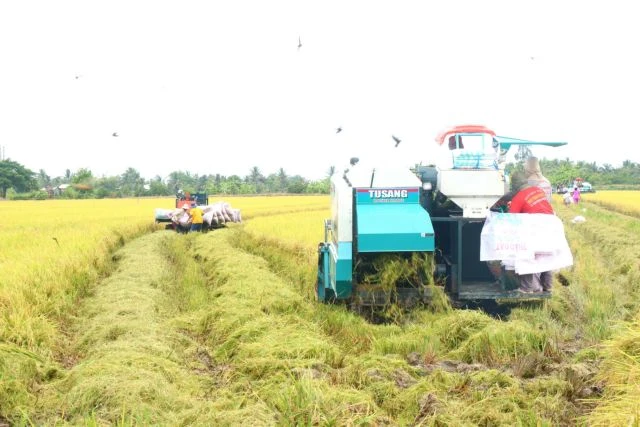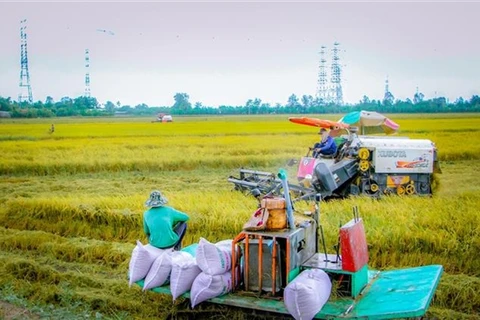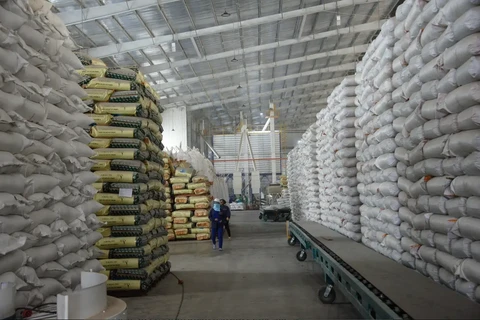
Can Tho (VNS/VNA) - A pilot model for planting millions of hectares of high-quality, low-emission rice in the Mekong Delta has yielded positive results, including reducing the amount of seed and fertiliser used, lowering carbon dioxide (CO2) emissions while increasing profits.
The findings were announced on July 8 at a review workshop for the initial results of the pilot model, held in Can Tho city.
The event was jointly organised by the Ministry of Agriculture and Rural Development, the Department of Crop Production, the International Rice Research Institute (IRRI), the People’s Committee of Can Tho city and the municipal Department of Agriculture and Rural Development.
Back on April 5, the Tien Thuan Cooperative in the city was selected by the Ministry of Agriculture and Rural Development as one of five sites across 12 provinces and cities in the delta to pilot the model.
The project saw 50ha of rice from the cooperative using certified seeds supplied by the Mekong Delta Rice Institute planted at a rate of 60kg per ha.
The cooperative ran a machine combining seeds with fertiliser, applying the mix to specialised zones, integrating pest management, applying mechanical harvesting and straw collection.
Speaking at the workshop, Nguyen Ngoc He, Deputy Chairman of the People's Committee of the city, said that the 50ha pilot field in Vinh Thanh district met all the criteria of the project to grow one million hectares of high-quality, low-emission rice linked to green growth in the Mekong Delta.
The model results showed a reduction in seed usage from 140kg per ha to 60kg per ha, a decrease in fertiliser applications from 3-4 times per crop to just twice per crop and a minimum 20% reduction in inorganic fertiliser use.
There was also a significant reduction in irrigation water, decreased risk of diseases and reduced post-harvest losses.
“The success of the model lays the foundation for the city’s agriculture sector to expand the project’s implementation across the entire committed area,” he said.
Nguyen Van Hung from the International Rice Research Institute said that the seed reduction of 60kg per ha saved 1.2 million VND (47 USD) and the reduction in fertiliser of 30kg per ha per crop saved 700,000 VND (27 USD).
Thus, the combined cost savings amounted to 1.9 million VND (74 USD) per ha.
After implementing the model, summer-autumn rice yields reached 6.13-6.51 tonnes per ha, about 7% higher than usual.
Lower input costs resulted in farmers increasing their profits by 1.3-6.2 million VND (50-240 USD) per ha.
Reduction of up to six tonnes of CO2
Nguyen Cao Khai, Director of the cooperative, said that the most significant benefit, besides cost savings and increased profits, was the reduction in environmental pollution due to the proper application of production processes.
Hùng, from the International Rice Research Institute, said that if the model was strictly followed, it could reduce greenhouse gas emissions by 2-6 tonnes CO2 per ha, depending on whether farmers followed water management practices in coordination with the cooperative.
The emission reduction was attributed to water and straw management.
Cao Duc Phat, Chairman of the Board of Director of the International Rice Research Institute and former Minister of Agriculture and Rural Development, said that the model aimed to achieve two main goals.
The first was to apply new technical processes to reduce costs, increase productivity and enhance value to boost farmers’ income.
The second was to reduce environmental pollution and greenhouse gas emissions by decreasing seed, pesticide and water usage, thus fulfilling Vietnam’s international commitments.
Phat hoped that the model would continue to spread across the delta and throughout the country.
“(By running the model), we are meeting the expectations of farmers and rice growers for a better life, higher incomes, a cleaner environment and contributing to the global effort to combat climate change,” he said.
Le Thanh Tung, Deputy Director of the Department of Crop Production, said that an essential factor besides the project’s criteria was the strong linkage between input suppliers, agricultural material companies and rice purchasing businesses for farmers.
The collaboration needed to be more practical and responsible, adhering to the commitments made by all parties in the coming time.
“These are the factors for the initial model’s success, which we believe can be expanded to the city and other provinces when implementing the project,” he said./.






















